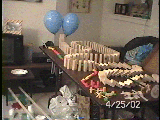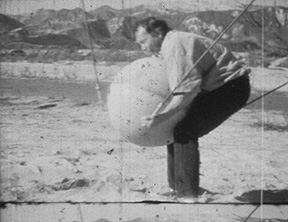Moving Art That You Can’t Leave Alone: Tim Fort and Gerald Smith at MAEP
Patricia Briggs describes the goings-on at the Minnesota Artists Gallery of the Minneapolis Institute of Arts during the month of September, when Tim Fort and Gerald Smith hold court.


“Art That’s Really Moving” by Tim Fort; “Can’t Leave It Alone” by Gerald Smith,
August 1 through September 21, 2003; in the
Minnesota Artists Gallery, Minneapolis Institute of Arts, 2400 Third Ave. S.
Walking into the Minnesota Artists Gallery at the Minneapolis Institute of Arts I got a bigger experience than I’d expected. Imagining that I would see the usual paintings or photos mounted on pristine gallery walls, perhaps some sculptures tastefully resting on pedestals and a handful of viewers secretly wishing they knew what the absent artists intended, instead I walked into an environment bustling with activity and encountered the two artists, Tim Fort and Gerald Smith, producing work and talking to museum visitors. That’s right–the artists were both in the gallery working independently on their own projects even though the exhibition has been open for over a month.
I found Fort tinkering with his latest “gadget,” a term he uses to describe the kinetic sculptures he makes mostly of popsicle sticks, but with other banal things as well–string, cardboard, plastic Lego bricks, bottles, washers, dominoes, pieces of metal drainage gutter. Fort spends hours (sometimes days) setting up sprawling low-tech assemblages, then he sets up a video camera and records the elaborate chain reactions he sets in motion as each piece of the structure responds to the one in front of it and in turn hits the one behind it. The show is over in less than a minute. It’s fun to watch hundreds of dominoes fall in lockstep, but Fort’s sculptures, which use a variety of materials arranged in complex patterns, are much more entertaining. Aside from his primary medium (the popsicle stick), Fort ingeniously programs plastic washers to hit glass bottles to the tune of familiar melodies, sets Xeroxed images flying into the air, and often plans enormous “stick bombs” (where hundreds of popsicle sticks fly into the air) as a finale.
Watching a gadget go off is cool (he usually sets one off twice a week during the run of the show—these events are called “Tumbles”), but if you miss a live performance you can watch an endless stream of video footage of gadgets in action on the large-screen televisions set up in the gallery. It’s mesmerizing; but is it art? I’ve never seen anything like it in a gallery before (expect perhaps a few pieces by Swiss artists Fischli and Weiss). Although Fort’s been featured on Channel 2’s Almanac and expects to have his gadgets featured soon on Worlds Funniest Home Videos this is his first gallery exhibition. I suspect it won’t be his last.
Smith works in another area in the gallery. I saw him sitting at a computer terminal talking to museum visitors inside a room-like structure. For all intents and purposes, Smith’s installation is a temporary studio pounded out of 2x4s and drywall with all the equipment he needs to produce artwork (video and sound equipment and a computer). Like any artist’s studio, this one is littered with fragments of earlier projects. There’s Smith’s cement version of the satellite he used in a film entitled My Sputnik, which also runs continuously on a small area on one of the walls of the structure, as do several of Smith’s other completed video and film projects.
As I talked with him, Smith shared portions of the new piece he is in the process of producing, which like much of his work deals with man’s engagement with technology. Clicking on a file on his desktop, a cow’s head and face pop onto the screen; the large red lips of an animated mouth start speaking in a sort of slow-witted voice that somehow one imagines a cow might have if a cow could talk. In the final piece, Smith explains, this cow and a couple of horses will carry on a conversation with a woman who is considering having herself cloned. They’ll all talk over the pros and cons. Viewers familiar with Smith’s work will recognize this artist’s uncanny ability to address serious subjects intelligently, but with delightful humor.
Why has Smith brought his studio into the gallery? His contention is that viewers miss a great deal when they see art in museums and galleries. When an artwork leaves the studio it is disconnected from the environment from which it emerged. This includes the tools and materials used to shape it, as well as the context of the artist’s larger body of work, parts of which are often on display in artist’s studios. The artist him- or herself is essentially banished from the gallery, where tradition would have viewers commune privately with a work of art. Though he is not arguing for the dismantling of the gallery system or the institution of the museum, Smith wanted to disrupt the received order of things in this exhibition, by offering viewers the opportunity to visit an artist in his studio.
You can find Smith working in the Minnesota Artists Gallery most weekdays until September 11, when he plans to convert the structure into a small gallery for the premier of his video piece on cloning. It’s unusual for me to visit an exhibition more than once, but I’ll be sure to return to this one before it closes on September 21.